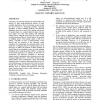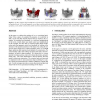402 search results - page 38 / 81 » Interactive function-based shape modelling |
ICDM
2003
IEEE
14 years 26 days ago
2003
IEEE
Clustering is an important technique for understanding and analysis of large multi-dimensional datasets in many scientific applications. Most of clustering research to date has be...
SIGGRAPH
2010
ACM
14 years 1 days ago
2010
ACM
In this paper, we address the problem of inverse procedural modeling: Given a piece of exemplar 3D geometry, we would like to find a set of rules that describe objects that are s...
BIRD
2008
Springer
13 years 9 months ago
2008
Springer
The inverse protein folding problem is that of designing an amino acid sequence which has a prescribed native protein fold. This problem arises in drug design where a particular st...
CVGIP
2007
13 years 7 months ago
2007
In this paper we introduce a framework for instrumenting (“rigging”) characters that are modeled as dynamic elastic bodies, so that their shapes can be controlled by an animat...
TOG
2012
11 years 10 months ago
2012
We present a method for controlling the motions of active deformable characters. As an underlying principle, we require that all motions be driven by internal deformations. We ach...


